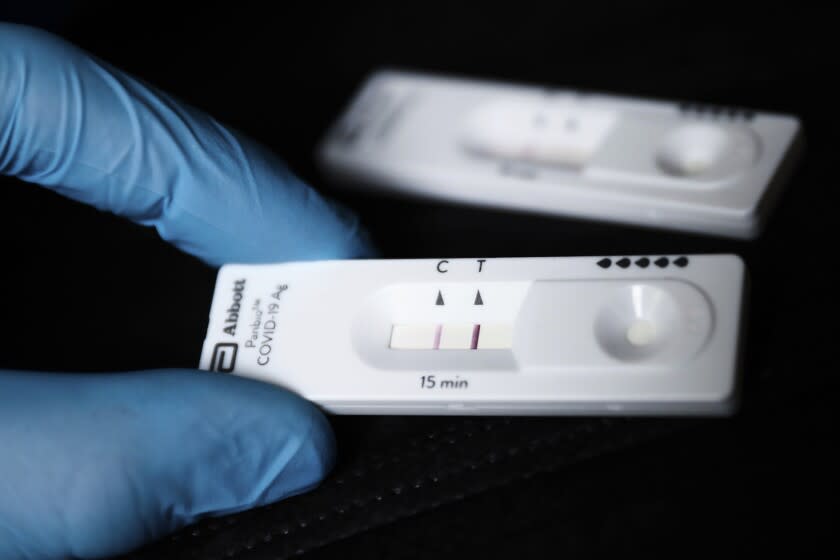Op-Ed: New COVID variants like BA.5 are dominating us — we can do more to prevent this

- Oops!Something went wrong.Please try again later.
It takes a lot for a COVID-19 variant to become dominant throughout most of the world. It has happened only three previous times (Alpha, Delta, Omicron) and now is occurring with the Omicron family subvariant known as BA.5. How did this occur and what are the implications for the pandemic going forward?
In the last weeks BA.5 became the dominant COVID variant in the United States, according to the Centers for Disease Control and Prevention, the cause of nearly 54% of new cases, growing exponentially here since late April. It replaced another Omicron family variant (BA.2.12.1), which has not achieved global dominance. But we are seeing BA.5, first appearing in South Africa and Portugal, now progressing to or achieving dominance throughout much of Europe, South America and the Asia Pacific. It has led to new infection surges and an increase in hospitalizations but, fortunately, not a proportionate increase in deaths or admissions to intensive care units.
The reason why BA.5 is a standout is predominantly linked to its property of "immune escape." That is, multiple distinct mutations from prior Omicron variants have blunted our immune response to it. The ability of multiple vaccine doses, boosters and infections to guard against it is reduced.
BA.5 doesn’t completely evade our defenses — there is some cross-immunity that is enabled by vaccines and prior infections, reflected in sustained protection from the most severe COVID illness. But the jump in reinfections, such as a recent doubling in San Diego Country, reflects our vulnerability.
BA.5 may have other “advantages” as well. Researchers in Australia just reported higher infectivity for this variant compared with prior Omicron versions, by virtue of its ability to enter cells more efficiently.
The rise of the BA.5 variant is an outgrowth of accelerated evolution of the virus. The transition from Omicron BA.1, first picked up spreading in late November 2021, to BA.5 now, with many other Omicron subvariants in between, is quite rapid and unlike the first year of the pandemic when there were no substantive new versions of the virus seen. BA. 5 puts the nail in the coffin of the myth that the virus will evolve into a milder form and fade away. We could easily see more variants — indeed a whole new family with more extensive immune evasion and growth advantage — in the months ahead.
So what should be done about the current situation and future prospects? More than we’re doing now.
The CDC has failed to warn Americans about the high risk of BA.5 spread, which can be mitigated to a significant extent by use of high-quality masks, physical distancing, ventilation, air filtration and booster vaccines. Only one in three Americans eligible has had a booster, which means the U.S. ranks 67th in the world for being up to date on protections against COVID. Among people age 50 and over, for whom a second booster has been shown to reduce mortality and severe disease and is freely available, only one in four has received it.
These boosters, while using the spike protein mRNA for the original strain of the virus, promote the overall broadening of our immune response and provide an important layer of enhanced protection to all variants. There is no reason for high-risk people to wait for a new vaccine booster, not knowing when that might be available or whether it will be more effective with the strain of the virus circulating at that time.
Beyond these currently available measures, we need to pull out all the stops to get ahead of the virus, for the first time in the pandemic anticipating its next moves and our vulnerabilities.
We need to apply money, pressure and government strength to the creation of a variant-proof vaccine. The scientific foundation for such a vaccine exists, but we must pierce regulatory concerns and get it done.
But even that’s not enough.
The “leakiness” of current vaccines and boosters for preventing transmission can be patched up by nasal spray vaccines, for which three candidates are in late-stage randomized clinical trials. Such vaccines achieve mucosal immunity, protecting against the entry of the virus into our upper airway, which shots are incapable of achieving for any durable basis, especially as the virus has evolved. Nasal sprays, like a variant-proof vaccine, deserve an Operation Warp Speed-like program to accelerate their success.
COVID isn’t conquered. The unprecedented acceleration, high efficacy and safety of the first vaccines, made available just 10 months from when the virus was first sequenced, is the model for what we should do next. We can’t be so foolish as to learn nothing from our pandemic past.
Eric J. Topol is a professor of molecular medicine at Scripps Research and author of the newsletter Ground Truths.
This story originally appeared in Los Angeles Times.

